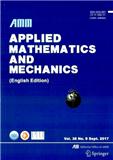| 投稿方式:官网投稿 |
- 栏目频次
- 单位占比
-
热词

低频栏目
-
更多
期刊简介
- 《应用数学和力学(英文版)》(AppliedMathematicsandMechanics(EnglishEdition))(月刊),创刊于1980年,是由上海市教育委员会主管,上海大学、中国力学学会主办的科技期刊。办刊宗旨(钱伟长院士亲自制定):发表力学、力学中的数学方法和近代力学密切相关的应用数学的创造性学术性论文。读者对象主要是从事与力学和应用数学有关的科研人员、工程技术人员和大专院校师生。自1997年开始被SCI收录,1990年开始被EI全文收录,是国内最早被SCI和EI收录的应用数学和力学类期刊,也是中国高校中最早被SCI和EI收录的期刊之一。
-
基本信息
- 期刊名称:应用数学和力学(英文版)(Applied Mathematics and Mechanics(English Edition))
- 主管单位:上海市教育委员会
- 主办单位:上海大学、中国力学学会
- 国内刊号:CN 31-1650/O1
- 国际刊号:ISSN 0253-4827;EISSN1573-2754
-
- 出刊日期:
- 期刊定价:
-
- 邮发代码:
-
- 所在省区:上海
- 邮政编码:
- 联系地址:
-
投稿信息
-
- 学科分类:力学
- 版面费用:待核实
-
- 字数要求:32000-48000
- 查重要求:-
-
- 复合因子:0.742
- 综合因子:0.6
-
- 审 稿 费:待核实
- 稿费:待核实
- 本刊可发:
- 特殊属性:第一批认定学术期刊,外文期刊
-
联系方式
- 投稿网址:https://mc03.manuscriptcentral.com/amm
- 官网网址:http://www.amm.shu.edu.cn
- 电话传真:021-66135219,66135601(202311期)
- 电子邮箱:amm@department.shu.edu.cn(202402期)
- 微信公众号:

